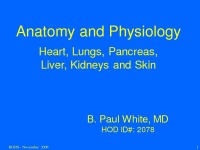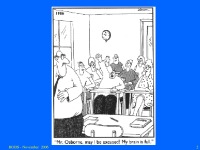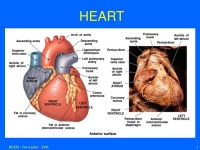Heart Anatomy And Physiology Slides



Anatomy and Physiology. Heart. Heart anatomy. Functions of the Heart. Cardiac Cycle. Blood Vessels. Blood Flow. Lungs. What do the lungs do? How do the lungs do this? Conducting Airways. How do the lungs do this? The Airways. How does gas exchange occur? Gas Exchange. Alveoli. Gas Exchange. Control of Ventilation. Pancreas. Anatomy of the Pancreas. Histology of the Pancreas. Bicarbonate Ion Production. Functions of the Pancreas. Bicarbonate Ion Production. Liver. Histology of the Liver. Functions of the Liver. Bile. Kidneys. Functions of the kidneys. Acid-Base Balance. Kidney. Internal Anatomy of Kidneys. Kidney Failure. Dialysis and Transplant. Skin. Functions of the Skin. Epidermis. Dermis. Layers of the Dermis. Subcutaneous Tissue. Skin Blood Vessels. Types of Burns. Partial Thickness Burn. Full Thickness Burn.
Hollow, muscular organ 300 grams (size of a fist) 4 chambers found in chest between lungs surrounded by membrane called Pericardium Pericardial space is fluid-filled to nourish and protect the heart.
The heart is a complex muscular pump that maintains blood pressure and flow through the lungs and the rest of the body. The heart pumps about 100,000 times and moves 7200 liters (1900 gallons) of blood every day.
The heart has four chambers. Two atria act as collecting reservoirs. Two ventricles act as pumps. The heart has four valves for: Pumping action of the heart. Maintaining unidirectional blood flow.
Generates blood pressure Routes blood Heart separates pulmonary and systemic circulation Ensures one-way blood flow Heart valves ensure one-way flow.
Regulates blood supply Changes in contraction rate and force match blood delivery to changing metabolic needs Most healthy people can increase cardiac output by 300–500% Heart failure is the inability of the heart to provide enough blood flow to maintain normal metabolism.
The heart is two pumps that work together, right (pulmonary) and left (systemic) half Repetitive, sequential contraction (systole) and relaxation (diastole) of heart chambers Blood moves through circulatory system from areas of higher to lower pressure. Contraction of heart produces the pressure.
- Medicine Presentations
- MS PowerPoint 8927 KB
- 2020 m.
- English
- 71 page (2388 words)
- Gymnasium
- Astijus
















